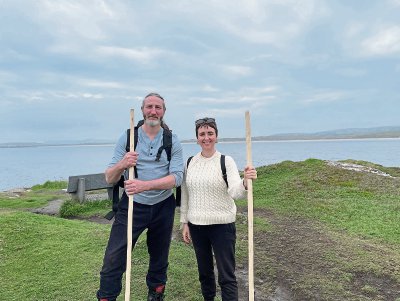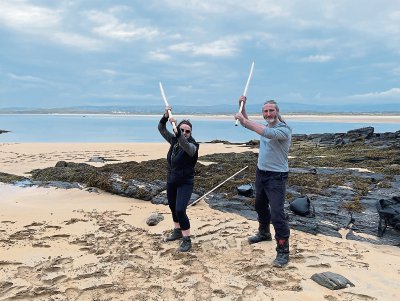By Evelyn Cullen
A WORKSHOP teaching the skill of reading the land took place at Ards Friary Retreat and Contemplative Ecology Centre last weekend.
Delivered by historian, seanchaí, artist and swordsmith, Charlie Gallagher from Letterkenny, the workshop focused on explaining the history, geology, ecology and biology of the ancient land we stand upon in Ards, Donegal and Ireland.
Participants were treated to a guided walking tour, which started at the Ards Friary centre, moving through the walking trail as far as Lady Isabella beach, where they stopped and received training on how to use a walking staff while navigating difficult terrain. The staffs were made by Charlie himself using wood from the hazel tree.
“The workshop is designed to physically engage you with the act of walking our land, as well as fostering local and indigenous knowledge and skills,” said Charlie.
“The staff is used for both navigating the land as well as for self defence,” he added.
One of the crucial ways a staff can be used is to help weaker or injured members of your group. Participants learned how to use the staff to pull someone up from a low position to a higher ground if they are struggling. As well as that they used the staff when walking uphill in a single file, with the strongest at the front, each person holding on to the staff of the person in front – forming a kind of human chain, keeping them together and helping the weaker members.
During this part of the workshop the group were joined by a curious seal, who sat on the sand and watched them, the tide being out.
There is a mound of rock on this beach, only the tip of which protrudes out from its embedded position in the earth, some half a mile down and is no less than 300 million years old, explained Charlie “the oldest rocks in Europe”. This mound of rock contains limestone and in fact is the same rock that Muckish is made from, but interestingly not Errigal. Errigal is made of quartzite and is even older at 700 million years old, participants were told.

Evelyn Cullen pictured with Charlie Gallagher who delivered the workshop at Ards Friary.
From there, the group moved on through the walking trail towards Lucky Shell beach, greeting other walkers and attracting attention with their large staffs and interactive approach, as they stopped for questions and answers as they went.
They learned about the trees including the Blackthorn, its thorny branches which grow out making it useful for defence around a structure.
The Sally trees (Willow) with their medicinal qualities as they contain aspirin, and the native Birch, its distinctive white bark that peels like paper mean it is always one of the first trees to colonise cleared or burned land, making it a pioneer species in forest regeneration.
From there the group made their way back to base to enjoy the famous cappuccino, made by the Capuchin Franciscan monks in the Ards café.
The story goes that in 1683 after the Battle of Vienna, when the Christian forces defeated the Ottoman Empire’s army, the Turks fled leaving behind bags of coffee beans, which were unfamiliar and considered too bitter by the Europeans. A Capuchin friar named Marco d’Aviano, who had acted as a spiritual advisor during the battle, is said to have suggested adding milk and honey to soften the taste. It became an instant hit and was then named after the Capuchin order in their honour.
The workshop took 2.5 hours and cost €50. Further workshops are planned for Sunday, June 29, Sunday, July 6 and Saturday, July 26.
Bookings can be made by contacting Charlie through his Facebook page, Charlie Gallagher.
Receive quality journalism wherever you are, on any device. Keep up to date from the comfort of your own home with a digital subscription.
Any time | Any place | Anywhere










